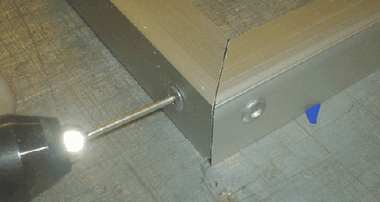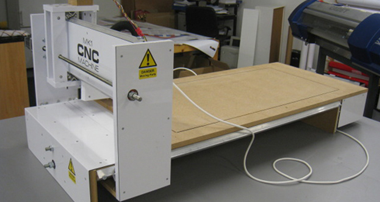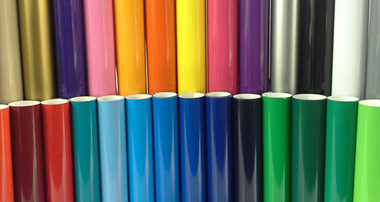Fixing Plastic Locators on Metal Letters


Hi, all I was reading my sign craft magazine the other day & I came to the advert page for cutting mats.
It also shows the” safety” straight-edge tool for cutting Foamex & the like. 100 inches long for $150! Great tool… but not cheap.
I thought I would do a demo on how “I” cut my foam board, corex & various other soft plastics.
Like the safety straight-edge tool, you will need something fairly decent to get a nice cut. This being the case I will start by showing you how I made my very “inexpensive” straight edge “safety” cutting tool.
This picture shows you the materials required to make your safety-cutting tool.
1 inch x 1-inch alloy angle, 2 soiled or old pieces.
1 piece of 1 mm aluminium, stainless steel or some other hard-wearing thin material. Width 7 inches x 36 inches (or whatever size you prefer)
Double-sided tape. (I am using VHB Tape, but this is not necessary)

This picture show the two lengths o trim I cut down. Easily done with a chop saw or hacksaw.
The straight edge I am making here is 36 inches long; this can be made to any size you wish. But make sure you make the angle about 1 inch short of the length of the straight edge.

This picture shows the piece of metal I cut 36 inches x 7 inches.
The best way to obtain this is to maybe ask the next time you’re in a sheet suppliers premises. They always have off cuts of metal all over the place.
Just ask for a piece or get one cut to required size. Normally they will do this free of charge.
The picture also shows the two lengths of angle I cut at 35 inches.
On the metal you will see two strips if double sided tape.
I have came in 1 inch from each side and run the tape the length.

Shows the finished rule.
I have the two lengths of trim in place.
Each one will protect your fingers and hand from any cuts from the blade.
I don’t know how many people I have seen, cut bits off the tops of their fingers
trying to cut sheet materials like this.
So that’s it. One safety straight edge for next to nothing!
These can easily be made narrower & one sided. so only the need for angle at one side. I have some 16” ones like this for cutting vinyl’s etc but prefer the double sided one for safety & over all grip.

Besides the safety factor of this straight edge. The main benefit has to be the pressure you can obtain over a length.
If we have a flat straight edge and hold in the middle with one hand while cutting. The top & bottom area of the flat metal is basically floating due to the fact it is impossible cover the length of metal with one hand.
Using the angle bar means, when pressure is applied in the centre of the metal the “L” shaped angle will allow pressure to travel up and down the length of flat metal, giving a better grip and wont slip.
Ok you now have your straight edge made from part one, now onto the cutting.
Ill go over some very simple do’s & don’ts then explain the directions to take when cutting.
This shows Foamex being cut.
Note, the right hand is raised. Keeping his knuckles about 1 inch from the surface. This is wrong!

This shows the same picture but this time the correct method is being used.
The right hand has its knuckles gently dragging on the surface.
The dragging should be used only to steady the hand and keep the blade at the right angle for cutting.
Also note, the left arm is being used to clamp the metal. Even though a single hand could do the job. Much more pressure can be obtained using your elbow, arm & hand.

Note, the knife is being held at the wrong angle. It is leaning to the left in the picture. The knife should be at the most vertical as possible, angle when cutting.
If the material was cut using the method shown the blade would creep under the straight edge and start to run off. Leaving a terrible finish.

Shows same cut being made but at the proper angle.
Looking at this picture, I have noticed the knife could be straighter again.
Well seeing i am the one holding the camera!

Here I will try and explain what I meant in pictures 1 & 2
Below is a picture of the blade at the all so common angle folk try and cut Foamex. It’s easy to fall into the habit! We think we should use as much pressure as possible to get through the material. In doing so the knife is raised at the rear and the nose is forced into the material being cut.
Wrong wrong wrong!
Take a close look at the end of the knife. Look at the amount of Foamex the knife covers. Only about 3-4mm

Now take a close look at the end of the blade.
The knife is using almost 3 times the amount of blade to make the same cut!
Using this method not only makes cutting easier, it also helps stop the knife running off in whatever direction your hand may sway.

Ok now the explaining is out the way, here is the procedure. Simple, simple short procedure. You may say yeh yeh! When you read it, but try it! As I have put here and take your time. It works 99% of the time for me!
You have your straight edge made.
You have your Foamex on the table.
You have your marks where the cut has to be made.
Now position the straight edge where the cut has to be made.
If it’s a short cut a hand is more than adequate if a long cut, over 2 foot i would use my elbow, hand & arm as shown.
Now take your Stanley knife. (Must be new or a very sharp blade)
Holding at the angle shown previous and very gentle but accurate drag the knife blade down the length. Keeping knuckles low & steady.
You should be left with a very faint line.
Do not move the straight edge one bit though.
The first initial scratch and I mean scratch is the most important.
Now, gently scratch it again. No pressure even if you’re tempted!
You should scratch it minimum of 3 times. On the forth apply a little more pressure, but remember you are not wanting to cut through just continuing
To get deeper fraction by fraction.
A 3mm bit of Foamex would take me about 7-8 steady cuts. Finished result is 100% perfect!

The whole point in this is to make the cut perfect.
Rushing will only cause you bother & your then back to square one.
Try the technique on an old bit then a longer bit and so on.
I’m saying no rushing it? This can be done fast with practice.
In the past I had staff say they hadn’t time to do it. Twice I bet them £10 if they could do it faster and have a better finish. I’m up £20

.
Robert Lambie






